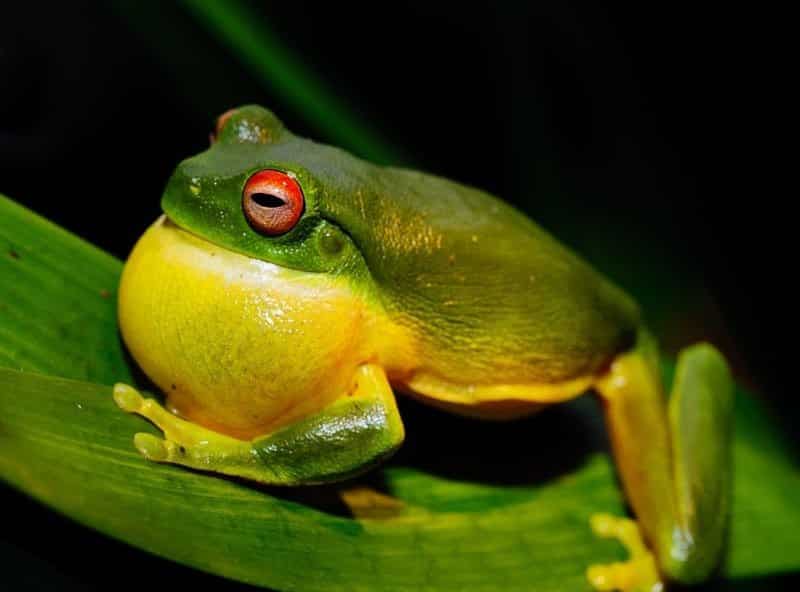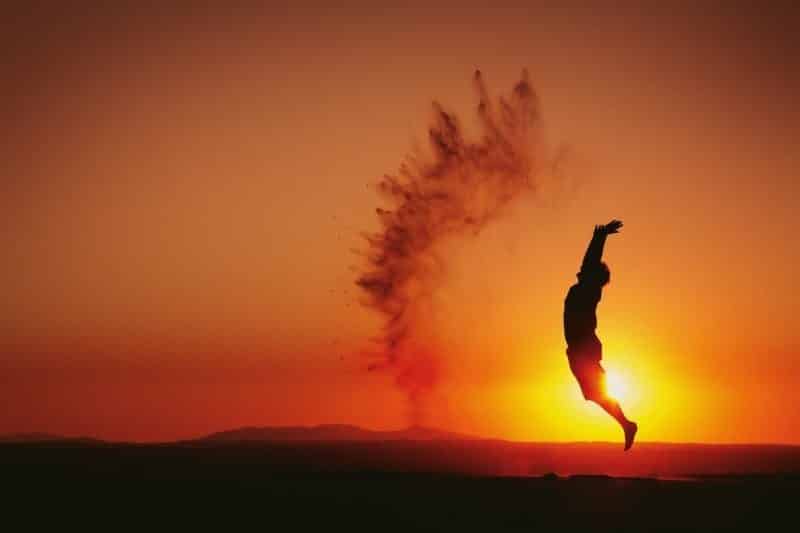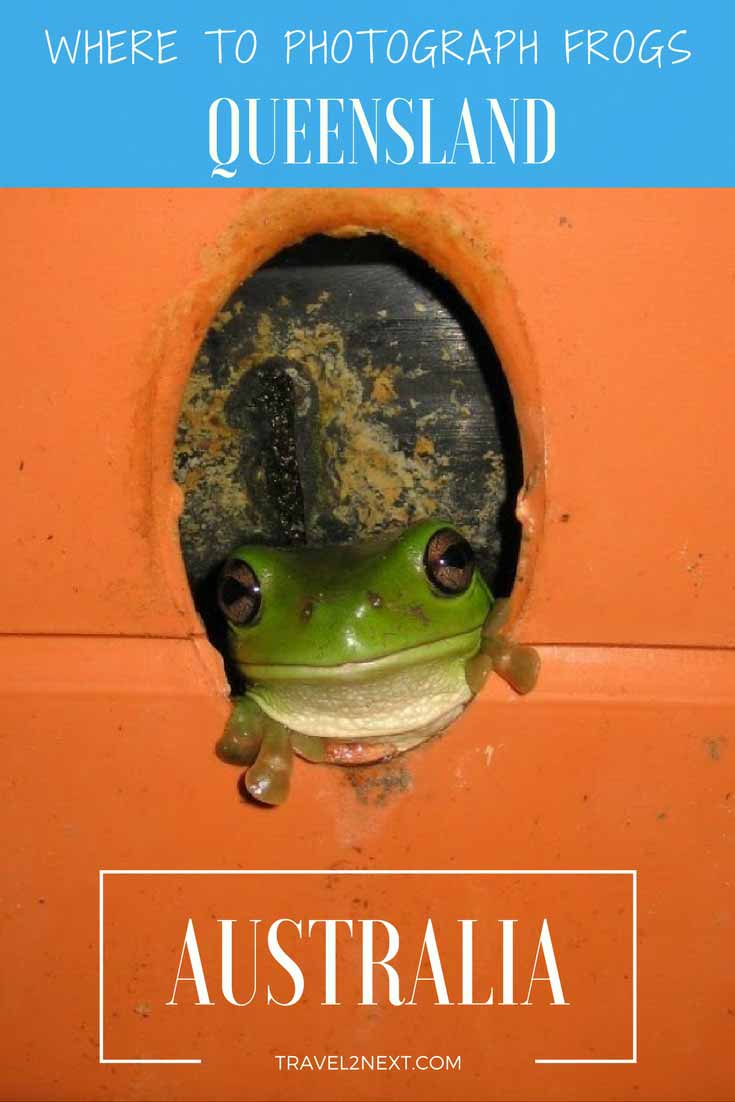Without a doubt, frogs are one of my favourite animals and I’m quite convinced I’m not on my own when it comes to liking frogs. Queensland frogs come in different sizes and colours.
There are big frogs and tiny frogs, smooth frogs and warty frogs.
Contents
- Where do frogs live?
- Australian Frogs
- Best places to spot frogs in Queensland
- 1- Cooloola Recreation Area, Great Sandy National Park
- 2- Goomburra section of Main Range National Park
- 3- Eungella National Park
- 4- Kroombit Tops National Park
- 5- Springbrook National Park
- 6- Tamborine Mountain
- 7- Mapleton National Park
- 8- Kondalilla National Park
- 9- Mount Lewis National Park
- 10- Girraween National Park
- 11- Fraser Island
- 12- Lilyponds Holiday Park
- Frog spotting tips
- Frog Facts
Where do frogs live?

Frogs live on every continent except Antarctica and occupy a diverse range of habitats including rainforests, grasslands and deserts.
Actually frogs are found everywhere except the ocean.
Australian Frogs
In Australia, there are more frog species in Queensland than any other state.
Queensland’s diverse frog fauna consists of 105 species.
They range from the recently discovered Andiirrmalin Frog (Litoria andiirrmalin) found in the boulder fields of Cape Melville to the tiny Northern Nursery-frog (Cophixalus crepitans) that live in the rainforests of the McIlwraith Range.
In summer, particularly after rain, the night air is filled with a cacophony of frogs croaking as males eagerly call for a mate.
Listening to a symphony of frogs is an incredible experience and one not easily forgotten.
They can be extremely noisy.
75% of all the frog species currently known in Queensland are found in the coastal areas between Cooktown in far north Queensland and southern Queensland.
National Parks are ideal for frog spotting.
Here are some tips on the best spots to find frogs.

Best places to spot frogs in Queensland
1- Cooloola Recreation Area, Great Sandy National Park
Situated on the Sunshine Coast, about 155km north of Brisbane, the Cooloola Recreation areas has a diverse landscape. From towering coloured sands cliffs to inland sand dunes covered in vivid heathlands, the constant moist conditions are perfect for frogs.

The heaths and swamps are home to many frogs including the Eastern Dwarf Tree Frog (Litoria fallax) and the Cooloola Tree Frog also known as the Wallum Tree Frog or Cooloola Tree Frog (Litoria cooloolenis) whose status is vulnerable.
Look among reeds surrounding coastal lakes and creeks for these tiny frogs. T
heir thighs are a bright red to an orange colour making them easy to identify.
2- Goomburra section of Main Range National Park

Travelling west from Brisbane, Main Range National Park is an easy 116km drive via a fully sealed road in south-east Queensland.
The park is renowned for its walking tracks – there are 23 listed walks from easy to difficult – and spectacular scenery with waterfalls and dramatic vistas from cliff ledges and its frogs.
This section has enticed naturalists for over a century and today’s visitors are not disappointed.
So far 31 frog species have been identified in this section alone.
The Green Tree Frog is human friendly and you’ll often find them sharing a part of your accommodation with you.
In the grasslands and open forest you will often see the Broad-Palmed Frog (Litoria latopalmata) who’s a little shy compared to his above relative.
3- Eungella National Park
80km west from Mackay in central Queensland, the moist-mist covered hills of Eungella are a refuge for many plants and animals.
There are 860 plants listed in this park alone.
It has become a favourite park for day trippers from Mackay or those seeking an extended stay, such as hikers on the Mackay Highlands Great Walk.
The Eungella Torrent Frog (Taudactylus eungellensis), only located in this region, is a small frog, so look closely.
It grows to around 28m. Over 22 species of frogs call this park home so there’s a good chance if you take a night walk you’ll encounter at least a few.
Eungella National Park is also considered the best place in the world to view platypus!
4- Kroombit Tops National Park


A remote park 85km west of Gladstone in central Queensland.
The park is dominated by sandstone bluffs.
Vegetation ranges from rainforest to dry eucalypt forests.
There are no facilities within the park.
Visit this park to hear the strange call of the endangered Kroombit tinkerfrog, an elusive frog found in rainforest areas.
Also worthy of seeing is the remains of a WWII Liberator bomber that crashed in 1945 remaining hidden for almost 50 years.
5- Springbrook National Park

Forming part of the Gondwana Rainforests of Australia World Heritage Area, Springbrook is only an hour’s drive south of Brisbane in the hinterland of the Gold Coast.
The region is home to ancient Antarctic beech trees, moss draped rainforest and cooler, drier open forest. Frogs love it here.
The best placed to find them is around the creeks and waterways.
Around O’Rielly’s guest house, you will often see green tree frogs.
On the walking tracks during the day frogs are harder to see, however at night frogs are a common sight.
As a diversion to your frog hunt, stop at the Natural Arch at night for its glow worms.
6- Tamborine Mountain

Tamborine National Park is Queensland’s oldest national park and the third oldest in the world.
It’s 80km south of Brisbane and 28km from the Gold Coast suburb of Nerang.
It’s the first mountain you see rising into the clouds from Gold Coast’s beaches.
The region protects 85% of all animal species and frogs are abundant.
Stay during summer and early autumn and the sound at night of the different species calling their mates is staggering.
The endangered Tusked Frog, the only species in Australia where the male is larger than the female survives here.
It’s easily recognised by the underside of the body’s distinct marbling and bright red groin.
7- Mapleton National Park
Travel north of Brisbane to the Sunshine Coast and you’ll find this picturesque park with waterfalls, rocky outcrops, creeks and bush – ideal for frog breeding.
Mapleton National Park is popular for walkers with many short walking tracks or for those that like a longer hike, the 58km Sunshine Coast Great Walk (Class 4) passes through the park.

Some of the frogs you may see include the Green Thighed Frog, Striped Marsh frog and Giant Barred Frog.
Don’t miss visiting the falls and Point Glorious with panoramic views of the hinterland and out to the ocean.
8- Kondalilla National Park

A fully sealed road leads to this park nestled in the Blackall Ranges, a short drive north of Brisbane and behind the Sunshine Coast.
The Kondaillla Falls are the main attraction falling 90m into a lush rainforest valley. Its here the rare pouched frog lives along with another 32 species of frogs.
There are numerous walking tracks and the Picnic Creek Circuit meandering along the creek and rock pools is ideal for frog spotting.
9- Mount Lewis National Park

Located in tropical far north Queensland, this park is 60km north-west of Cairns.
Accessible only by 4WD or mountain bike the mountain is often shrouded in clouds keeping it cool and moist.
It’s become a popular park for wildlife viewing especially birdwatching.
Over 32 species of frogs can be seen in the park including the white-lipped treefrog (Australia’s largest green tree frog) and the northern laughing tree frog.
10- Girraween National Park

Allow a couple of days to drive the 260km south-west of Brisbane to this park on the border of Queensland/New South Wales.
A highlight here are the huge granite outcrops prefect hideouts for bushrangers in days gone by.
It’s easy to see why the region is called the Granite Belt.
Girraween means ‘place of flowers’ and in spring the wildflower displays can be spectacular.
Look closely as burrowing frogs are often seen on the tracks after rain.
It’s also a premier wine producing area.
11- Fraser Island

A visit to the largest sand island in the world is in most top lists of things to see and do on a visit to Queensland.
There heritage-listed island lies just off the coast from Hervey Bay approximately 200km north of Brisbane.
Two top locations here for frogs is along Wanggoolba Creek and at Kingfisher Bay Resort. The resort rangers conduct night walks.

12- Lilyponds Holiday Park
Lilyponds Holiday Park has a fabulous night tour around the park identifying the different frog species.
More than 15 species have been sighted within the park, especially in summer.
You’ll often hear the Striped Marshfrog and the Great Barred Frog (as photographed by Jodie Bray below) along with others.

Green tree frogs love living in homes in Queensland and will often be found in letterboxes, drains, shoes, even the toilet!

Frog spotting tips
Frogs like a moist, unpolluted environment.
Because they have a permeable skin and lose water quickly they need an environment with moisture and good ground cover such as leaf litter and other debris.
In the outback frogs will bury themselves way underground only coming out after good soaking rains.
They can remain underground for at least three years.
The best time to spot frogs is at night.
Listen to their call and simply follow it.
Don’t forget a torch and wear closed in shoes.
The main predators of frogs are snakes and night is when most snakes will be out for their dinner.
Jodie Bray, also says to look for eye shine at night as it’s another great way to find frogs when using a torch.

Are you a frog lover? Save the Frogs Day is the last Saturday of April.
Frog Facts
What is a group of frog called?
The collective noun for a group of frogs is an army, a colony or a knot
- Frogs do not need to drink, as they can absorb water through their skin
- Frogs have long legs that enable them to jump up to 20 times their body length
- Frogs are good swimmers due to their webbed feet
- Frogs can lay up to 4,000 eggs
- Frogs can breath underwater as their nose is on top of their head
- Frogs have periscope vision due to their eyes being on top of their heads
- Frogs love to eat bugs and worms
- Cameroon’s Goliath frog is the biggest frog in the world, with a body up to one-foot long but frogs can also be tiny (around half-an-inch long).
- Male frogs in the Seychelles carry their babies on its back until they grow up
- A herpetologists is an expert on amphibians and reptiles, including frogs.
- Scientists are able to work out the age of a frog by its bones, which forms rings as each year goes by.
- Desert frogs can survive for up to seven years without water
- Frogs have black and white vision and are unable to see colour
- The deadliest frog on earth is the Golden Dart frog, which can kill 1,000 people with its skin.
- The male Darwins Frog will put its mate’s eggs in its mouth and keep those eggs there until froglets hatch.
- Frogs are unable to survive in salt water
- There are more than 4,000 types of amphibians in the world
- Tropical frogs have bright colours to warn predators that they are poisonous
For more places to see wildlife in Queensland check out:

Plan Your Trip

Rent A Car – Find the best car rental rates at Discover Cars. They compare car hire companies to provide you with the best deal right now.

Find A Hotel – If you’re curious about this article and are looking for somewhere to stay, take a look at these amazing hotels.



